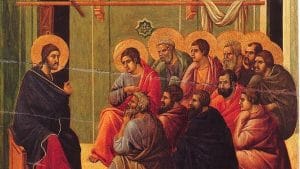By Connor Szurgot
When speaking of the Blessed Trinity, the Catechism of the Catholic Church states, “the mystery of the Most Holy Trinity is the central mystery of Christian faith and life. It is the mystery of God in himself.” (CCC 234) Beyond even that epic and truly awe-some reality is the reality that, since every cause is in some way in its effect, all of created reality is in some way Trinitarian. One of the clearest examples of this Trinitarian symbolism in created reality is the family. As such, the devil seeks to attack the Blessed Trinity through His image: the family.
A Community of Persons, United by Love
Through the mystery of the Trinity is not able to be fully comprehended by man, certain facts about the mystery can be understood. Some of those facts are: 1) There is one Divine nature, 2) there are three distinct Divine Persons in the Godhead, 3) each of these Divine Persons is co-equal, co-eternal, and fully God, 4) each of the Divine Persons is only differentiated from the others by their relations to the other Persons. These relations are as follows: 1) the Father, the first Person of the Trinity, eternally begets the Son, the second Person of the Trinity and 2) the Holy Spirit, the third Person of the Trinity, eternally proceeds from the Father and the Son. Without delving too deep into this mystery, it is important to understand that all three Persons are united in love. The Father loves the Son and the Son loves the Father and this eternal perfect love between the Father and the Son is the Holy Spirit.
With that understanding established, it is not hard to see how the family images this. A man and women love each other so much as to give themselves to each other in the life-long bond of matrimony and the fruit of their married love is a child. What unites them in the child on a material level are their shared genes. (Indeed, the father and the mother are in a way now more completely united since the child is the product of both of them.) Yet, beyond the material level, the are united in mutual love, one for another. Also, each member is distinct in their role within the family. They are a community of persons, united in love, that images the community of Persons, united in eternal love.
The First Attack: Gender Theory
Progressive gender theory advances the idea that men and women are the same. This positions leads to two conclusions: 1) to be a ‘man’ or a ‘woman’ has no actual meaning and 2) that one can switch between being a man or a woman at will because what you are is defined only by what you think you are. In addition to the obvious absurdity of this claim, a problem with this is shown by a passage from Genesis, “So God made man in his own image, made him in the image of God. Man and woman both, he created them.” (Gen. 1:27) Notice two things: 1) that God clearly created two distinct sexes and 2) that He created them in the image of God. Clearly, the complementarity of man and woman are supposed to reveal, in a subtle way, something about the Trinity.
The complementary of man and woman is supposed to model the relationship of the Father and the Son. The Father (the man) eternally loves and gives Himself to the Son (the woman) Who receives Him and gives Himself back in return. The man is the giver in the relationship while the woman receives him and gives herself back in return. The natural inclinations in man and woman show this to be true and to attempt to defy this is not only to make oneself miserable, but to destroy this image of the Trinity in man.
The Second Attack: Divorce
Divorce is the first of these three attacks that has found its way into mainstream acceptance among Protestant Christian circles. This is strange since Christ is very clear that, “[husband and wife] are not two, but one flesh. What therefore God hath joined together, let no man put asunder.” (Matt. 19:6) This practice attacks the Trinity by destroying the Love that binds the Father and the Son together, the Holy Spirit. When a man and woman give themselves to each other in marriage, something new is created even before they step away from the altar. The objective reality of their marriage comes into being and exists in a way that is separate, but dependent on the two people in the marriage. This dependency is not upon the will of the two people joined, but upon their lives. Their marriage will objectively exist until death do they part.

When a couple divorces, they tear apart and divide what God has created to be the symbol of His Unity in the Trinity: the family. The painful effects of such a rupture are often far reaching. It can be particularly damaging to the children of their marriage, who have lost what was supposed to be their image of complete and unconditional love—their image of God on earth.
The Third Attack: Contraception
The second attack of the three that has broken through the walls of the broader Christian kingdom and proceeded to pillage and destroy the interior of that kingdom is contraception. At the beginning of Creation, God gave all animals the blessing of the ability to produce another being like itself. Only in man, however, can we call this blessing procreation instead of reproduction. Only man has been given the privilege of assisting God in the creation of new souls. It is a privilege so important and sacred that it has always been entrusted to two people and marked with a degree of pleasure befitting the goodness of such an act. Moreover, it is a power which makes man truly God-like in the love which motivates it. To will to bring into existence a creature that you will care for and sacrifice for and who has done nothing for you, is indeed incapable of doing anything for you at the beginning, is an act imaging the love that drove God in the act of creation.
The act of contraception, however, opposes the image of the Trinity by removing from a man and woman the natural end of their love and the damage caused by this removal is proportional to the good it damages. While a single contraceptive act, even between a man and wife, is gravely sinful as it opposes the end set forth by the natural law, the effects of a contraceptive mindset are even more terrifying. Through the adoption of a contraceptive mindset, our culture has separated marital love and the creation of children into two separate camps. The fruits of such a separation are bountiful in our culture: pre- and extra-martial relations, masturbation, pornography, abortion, fatherless children, the acceptance of homosexuality and numerous other sexual disorders. It paves the way for marital love, which is supposed to express perfect self-giving to another, to corrupt into selfishness and mutual use. The Trinity shows that love is fruitful by its very nature. The love between the Father and the Son spirates out from them and is another Person. To act contrary to the natural end of love is to act contrary to love itself.
The family is the building block of society and God has will that it be the building block of the supernatural society of the Church as well. He has also made it the natural image for His very Nature, the greatest mystery of the Catholic faith. We must defend this great gift from God which has been entrusted to us by living and proclaiming the truth.

